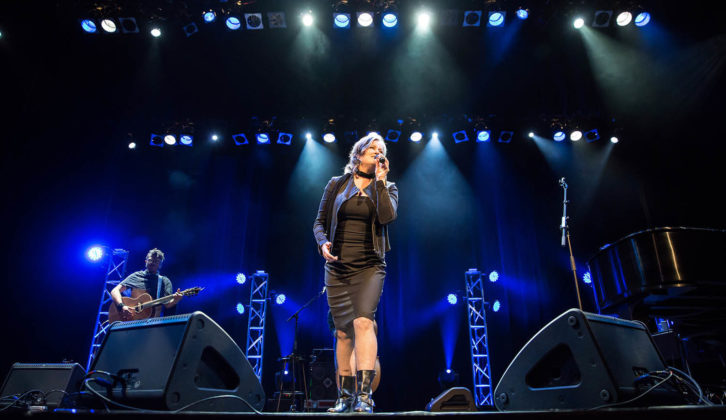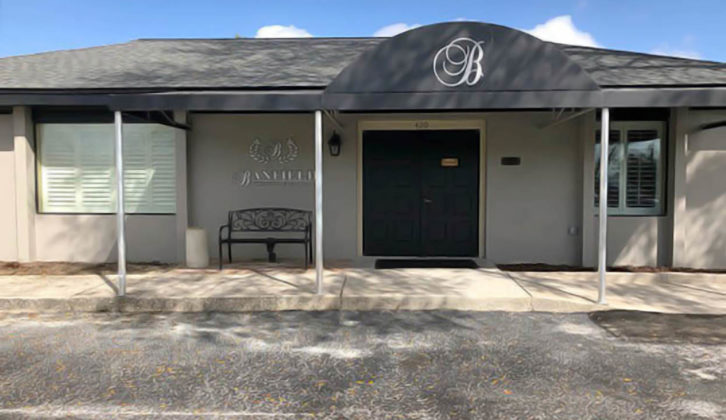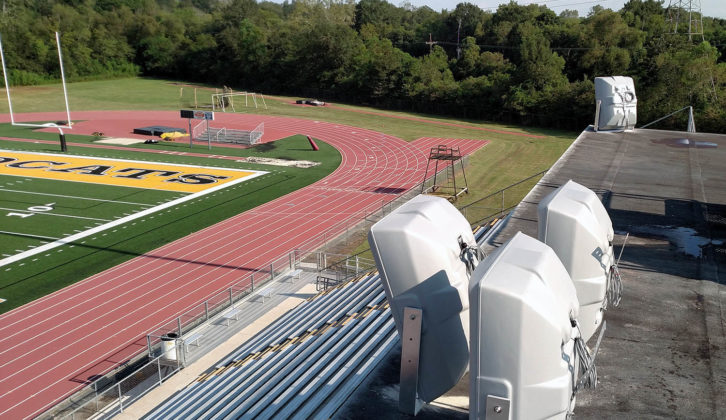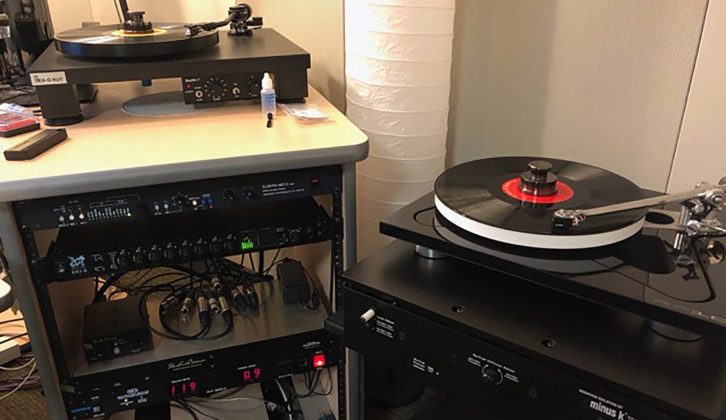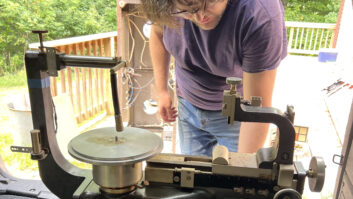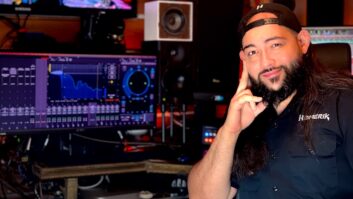Brooklyn, NY—Aaron Zimmer was running a successful one-man agency, Leesta Vall, booking up to 1,500 shows a year for a roster of two dozen artists, when he purchased a Presto K8 portable vinyl record lathe on eBay and—hey presto!—he switched careers. Well, not so fast.
Having acquired the Presto, manufactured in the 1940s, “I set it up at my kitchen table and just banged my head against the lathe for a couple of years trying to get it all to work,” says Zimmer. “I bet I cut 5,000 bad records before I got one good one.”
The idea began as an art project, with Zimmer recording friends and roster artists using a single microphone in his 10- by 10-foot room. “We got started in February 2017. By late summertime, as the project grew, I started shrinking the roster until I didn’t have one. We converted the agency to full-on lathe-cut vinyl and have been doing it ever since.”

Leesta Vall Sound Recordings gradually expanded from one to three rooms at New York Studio Factory in Bushwick. In December 2018, Zimmer relocated to a facility in Greenpoint, where he is just applying the finishing touches to his renovations.
He was initially drawn to “this community of lathe-cut nerds” after seeing Jack White’s 1947 Voice-O-Graph vinyl recording booth—which Neil Young used to record his 2014 A Letter Home album—on The Tonight Show Starring Jimmy Fallon. “I was in love with the idea that you could walk into a booth, make something and leave with a record,” he says.
Related: The Bakery Serves Up Vinyl and More, by Steve Harvey, April 4, 2017
Many in the community offer short runs of 25 or 50 copies, Zimmer says, but he hit on a novel idea: have each artist produce a unique record to order. “I couldn’t find anybody in the world doing something like that in a way that artists could engage their fanbase and make a little bit of money. And maybe I could make a little bit of money.”
Every session, and there have been nearly 700, now follows a preorder model. “The artist makes a list of songs available and fans can go to the webpage and preorder the song they want. When the artist shows up for the session, we already know who we’re cutting the records for. The beautiful thing for the listener is that we cut that record specifically for them, which includes a message from the band, right on the record.”
The average session, he calculates, is 18 to 20 cuts. “It’s not abnormal to cut 10 or 30 records in a session. I think the most we had in one campaign was 80. We generally won’t go that high; it’s an endurance contest for the band.” That particularly popular performance was by a local TV star and was split across four or five recording sessions.
As for revenue sharing, he says, “We split 50/50 with the artist after costs. The records generally sell for $25 on the website; they cost about $5 in supplies to make, so there’s a royalty split of $10 for the band and $10 for the label.”
Originally from the Midwest, Zimmer spent years touring as a singer-songwriter. “I was making my roots here in New York City and was collecting old tape stuff and vintage outboard and was able to put together a tiny closet with a Tascam M388,” a combination mixer and quarter-inch 8-track machine. “That’s where I got my feet wet. I’ve done a lot of recordings in Pro Tools in real studios, but old equipment and keeping things small was always more fun and more meaningful for me.”
Related: Nashville’s Welcome to 1979 Goes Direct-to-Disc, by Steve Harvey, Oct. 14, 2015
Despite his recording experiences as an artist, “I don’t have Pro Tools or know how to use it. I never identified with recording to a computer. It has always been more fun for me to record when you realize you have limitations.”
Zimmer now has a Tascam M38 half-inch 8-track machine and occasionally records to tape for pressed vinyl projects. “I love the old Tascam stuff,” he says. Yet even with tape, he prefers the single-take workflow. “I don’t mind a vocal or guitar overdub, but I prefer to get the whole track again, so there’s a good take.”
His Tascam M50 mixing desk from the ’80s recently died and has been replaced temporarily by a Yamaha console. “Something vibey and analog is where we’ll go. We’ll get a Trident or something like that.”
Zimmer initially focused on singer-songwriters because he had just one mic. Now he has a larger mic collection that includes various Audio-Technica models thanks to an endorsement by the manufacturer. There was an iso booth for drums at the NY Studio Factory, but the new Greenpoint location has a different layout, enabling larger ensemble recordings, he reports. “The entire band is in one live room; I had a seven-piece in there last week.”

Leesta Vall’s racks are stacked with Universal Audio LA-610, 4-710d and 710 Twin-Finity mic preamps. “I’ve got a few Warm Audio pre’s I like to use for drums,” he says. “Outboard, I’ve got a couple of old Furman RV-1 spring tanks, and I’ve got an EL8 Distressor that I use on a drum bus. All that gets mixed and sent to a Warm Audio WA-2A limiter, the LA-2A copy. That sends the signal to the cutting preamp, and that delivers the signal to the cutting head.”
He’s a fan of Warm Audio products: “The prices are good, and they sound pretty darn good. I’ve never A/B’d the WA-2A to the real thing, but it does a good job for us. And I love their preamps.”
Related: The Lathe of Heaven? by Clive Young, Nov. 12, 2009
The lathe is a Rek-O-Kut Imperial, made in Long Island City, NY, around 1951, says Zimmer. He also has a tiny Atom, made in Japan in the ’80s during the original karaoke craze for people to memorialize their singing—just as cassette tapes launched. “The company didn’t do well,” he laughs.
The Atom has captured numerous record store in-store performances, open mic events and live shows. The most recent was Rachael & Vilray (featuring Rachael Price of Lake Street Dive) at Manhattan’s Rockwood Music Hall, says Zimmer. “They sang into one ribbon microphone. Every song they played at the show was cut to its own record and we sold them right there.”
Audiophiles might sneer at the quality, but as Zimmer comments, “For the listener, they don’t care what it sounds like; they don’t pick up on the nuances. What they want to hear is a good performance. All the projects capture spontaneity and good musical ability right in the moment. That’s what makes a recording so special.”
Leesta Vall Sound Recordings • leestavall.com
Facebook @leestavall
Instagram leestavall
Twitter @leestavall
Want more stories like this? Subscribe to our newsletter and get it delivered right to your inbox.
